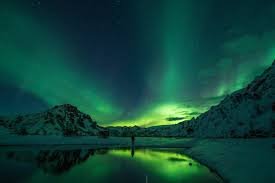The magical Aurora Borealis, more commonly known as the Northern Lights, is one of the most spectacular natural phenomena you can witness on Earth. And there’s no better place to chase these dancing lights than the land of fire and ice—Iceland. This comprehensive Guide to Northern Lights in Iceland will take you through everything you need to know to plan the perfect aurora-hunting adventure, from when and where to go, to how to increase your chances of catching a glimpse of this bucket-list spectacle.
What Are the Northern Lights?
The Northern Lights are a natural light display that occurs when solar particles collide with gases in Earth’s atmosphere. These collisions create shimmering waves of green, pink, purple, and even red hues across the night sky. The lights are most commonly seen in regions close to the Arctic Circle, and Iceland is one of the top global destinations due to its geographical location, low light pollution, and accessible dark skies.
Best Time to See the Northern Lights in Iceland
A critical element in your Guide to Northern Lights in Iceland is timing. The best time to see the aurora is during the winter months—from late September to early April. During this period, Iceland experiences long nights, often with up to 20 hours of darkness, creating ideal conditions for aurora viewing.
The Northern Lights are not visible in summer because of the midnight sun, but autumn and winter provide enough darkness to see them clearly. Clear skies are essential, so always check the aurora and cloud cover forecast before heading out.
Where to See the Northern Lights in Iceland
Location is everything when it comes to witnessing the aurora. Iceland offers several prime spots, and this Guide to Northern Lights in Iceland highlights a few key areas. Thingvellir National Park is not only a historic and geological treasure but also a hotspot for aurora sightings. The vast open landscapes and low light pollution make it a favorite among locals and tourists alike.
Another popular place is the Snaefellsnes Peninsula, often called “Iceland in Miniature” because of its diverse landscapes. The remote Westfjords and areas near Lake Mývatn in the north also offer incredible opportunities to see the lights in a quiet and serene setting. If you’re staying in Reykjavik, don’t worry—you can still catch a display by driving just 30 to 45 minutes away from the city lights.
Guided Tours vs. DIY Adventures
One important aspect of any Guide to Northern Lights in Iceland is deciding whether to go on a guided tour or hunt for the lights yourself. Guided tours are a great option for first-timers. Tour operators know the best locations based on weather and aurora forecasts. Many even offer a free second trip if you don’t see the lights on your first attempt.
However, if you’re more adventurous and have a rental car, a self-guided chase offers flexibility. Keep your eyes on the aurora forecast apps and websites, drive out into the countryside, and let nature do the rest. Whichever option you choose, be sure to dress warmly—it can get extremely cold while waiting outside at night.
Tips for Photographing the Northern Lights
Capturing the aurora on camera can be just as satisfying as seeing it with your eyes. Any Guide to Northern Lights in Iceland would be incomplete without some photography tips. A DSLR or mirrorless camera with manual settings and a sturdy tripod is a must. Set your ISO between 800-3200, use a wide aperture (f/2.8 or lower), and experiment with shutter speeds between 5-25 seconds depending on aurora movement.
Use a remote shutter or self-timer to avoid camera shake. Also, consider scouting your location during the day so you’re ready when the sky comes alive. A full moon can help illuminate the landscape, creating even more breathtaking shots.
Weather and Safety Considerations
When following a Guide to Northern Lights in Iceland, remember that Icelandic weather is unpredictable. Storms, snow, and rapidly changing conditions are common, especially in winter. Always check road and weather reports before setting out. Pack essentials such as water, snacks, a flashlight, and emergency blankets if you’re traveling by car.
It’s also a good idea to share your plans with someone or use a location-sharing app. If you’re on a guided tour, rest easy knowing safety is a priority for most operators.
Why Iceland is the Ultimate Northern Lights Destination
What sets Iceland apart is not just its proximity to the Arctic Circle but also the sheer beauty of its landscapes. Imagine watching the Northern Lights while standing next to a frozen waterfall, on a black sand beach, or near a steaming hot spring. The country’s natural wonders amplify the magic of the aurora experience.
Another reason this Guide to Northern Lights in Iceland emphasizes the location is the accessibility. In just a few hours’ drive from Reykjavik, you can reach prime viewing spots. Add to that the chance to explore volcanoes, glaciers, and geysers during the day, and you have the ultimate winter escape.
Final Thoughts on Chasing the Aurora in Iceland
To wrap up this Guide to Northern Lights in Iceland, it’s important to stay patient and optimistic. The aurora is a natural phenomenon, and while no one can guarantee a sighting, those who plan well and keep an open mind often find the reward well worth the wait. Whether you choose a luxury tour or set out into the wilderness on your own, seeing the Northern Lights in Iceland is a magical experience that stays with you for a lifetime.
So pack your warmest clothes, keep your camera ready, and prepare for a journey into the heart of the Arctic night. Iceland is calling—and the lights are waiting.
